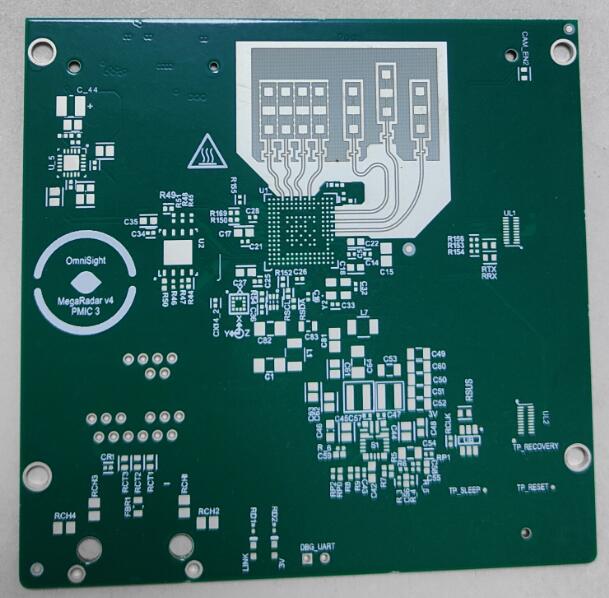An automotive radar PCB (Printed Circuit Board) is a specialized circuit board used in automotive radar systems. Automotive radar is a technology that uses radio waves to detect objects and obstacles in the vicinity of a vehicle, providing crucial data for various advanced driver assistance systems (ADAS) and autonomous driving features.
The automotive radar PCB is designed to accommodate the specific needs and requirements of radar systems used in vehicles. These PCBs are typically engineered to be:
- High-Frequency: Automotive radar systems operate at microwave frequencies, typically in the 24 GHz or 77 GHz bands. The PCBs must be designed to handle these high-frequency signals accurately and efficiently.
- RF (Radio Frequency) Design: The layout and traces on the PCB must be carefully designed to minimize signal loss and interference. This involves ensuring controlled impedance, minimal signal reflections, and reduced crosstalk.
- Antenna Integration: Radar PCBs often incorporate antenna elements, which are critical for transmitting and receiving radar signals. The PCB design must accommodate these antennas, which can be patch antennas, horn antennas, or other types depending on the radar system.
- Signal Processing: Automotive radar systems require signal processing circuits and components on the PCB to process the data received from the radar sensors, such as object detection and tracking.
- Rugged and Reliable: Automotive environments can be harsh, with temperature variations, vibrations, and exposure to moisture and other elements. Radar PCBs must be built to withstand these conditions and ensure the reliability of the radar system.
- Compact and Space-Efficient: Space within a vehicle is limited, so radar PCBs must often be designed to fit into small, specific locations within the car’s body, often near the front grille or in other strategic positions.
- Compliance: Automotive radar PCBs must comply with industry standards and regulations, ensuring that they do not interfere with other vehicle systems and that they meet safety requirements.
These specialized PCBs are a crucial component of automotive radar systems, enabling vehicles to sense their surroundings and make decisions related to collision avoidance, adaptive cruise control, lane-keeping assistance, and other advanced safety and autonomous driving functions.
What should be noted when producing automotive radar PCBs?
Producing automotive radar PCBs requires careful attention to various factors to ensure the reliability, performance, and safety of the radar system. Here are some important considerations when manufacturing automotive radar PCBs:
- Material Selection: Choose high-quality PCB materials suitable for high-frequency applications. Common materials for automotive radar PCBs include FR-4, PTFE-based materials like Teflon, and specialized laminates designed for RF and microwave applications.
- Controlled Impedance: Maintain controlled impedance traces to ensure signal integrity. This involves carefully designing and manufacturing the PCB to match the desired impedance of the radar system, typically 50 ohms for RF applications.
- Antenna Integration: If the radar PCB includes antenna elements, ensure that they are accurately designed, placed, and tuned for the specific radar frequency and beam pattern required. Antenna integration is critical for radar performance.
- PCB Layer Stackup: Define an appropriate layer stackup to meet the signal and power distribution requirements of the radar system. Consider the number of layers, copper thickness, and dielectric properties to optimize signal performance and isolation.
- RF Design Considerations: Minimize signal losses, reflections, and crosstalk by following best practices for RF PCB layout, such as avoiding sharp bends in traces, using ground planes effectively, and keeping RF components close together.
- Thermal Management: Implement effective thermal management solutions, especially if the radar PCB is expected to operate in high-temperature environments. This may include thermal vias, heat sinks, or other cooling mechanisms.
- Component Placement: Carefully position radar components on the PCB to optimize signal paths, reduce interference, and ensure efficient assembly. Keep in mind the overall size and form factor constraints of the automotive radar module.
- EMI/EMC Compliance: Consider electromagnetic interference (EMI) and electromagnetic compatibility (EMC) requirements to ensure that the radar PCB does not interfere with other vehicle systems or external devices. Use shielding and filtering components as needed.
- Environmental Durability: Ensure that the PCB can withstand the harsh automotive environment, including temperature variations, vibrations, moisture, and exposure to chemicals or contaminants. Coating the PCB with conformal coatings can provide additional protection.
- Quality Control: Implement stringent quality control and testing processes during PCB fabrication and assembly to detect and address any defects or issues early in the production process.
- Regulatory Compliance: Verify that the PCB design and production processes comply with relevant automotive industry standards and regulations, such as ISO 26262 for functional safety in automotive systems.
- Traceability: Establish traceability throughout the production process, including documenting materials, manufacturing steps, and component sources. This is crucial for quality assurance and any potential recall or maintenance efforts.
Producing automotive radar PCBs requires expertise in RF and microwave design, as well as a deep understanding of automotive industry requirements and standards. Collaboration with experienced PCB manufacturers and adherence to best practices is essential to ensure the successful production of reliable radar PCBs for automotive applications.

